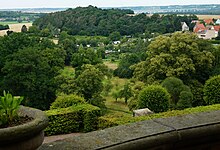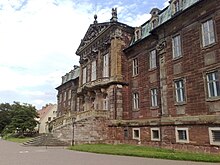Castle divisions
|
Castle divisions
City of Laucha on the Unstrut
Coordinates: 51 ° 14 ′ 44 " N , 11 ° 38 ′ 28" E
|
|
|---|---|
| Height : | 130 m above sea level NN |
| Area : | 8.36 km² |
| Residents : | 583 (Dec. 31, 2007) |
| Population density : | 70 inhabitants / km² |
| Incorporation : | July 1, 2009 |
| Postal code : | 06636 |
| Area code : | 034462 |
Burgscheidungen is a district of the town of Laucha an der Unstrut in the Burgenland district in Saxony-Anhalt .
geography

Burgscheidungen lies on the Unstrut between Nebra and Laucha in the Saale-Unstrut-Triasland nature reserve. In addition to the main town of Burgscheidungen on the left bank of the Unstrut, the district of Tröbsdorf on the right bank of the river belonged to the former municipality of Burgscheidungen.
history
The castle hill towering over the place has been around since 3000 BC. Settled. During the migration period there was an important castle here, possibly even a residence of the Thuringians , whose empire stretched from the Elbe to the Danube near Regensburg. In 531 the Thuringians and their King Herminafried are said to have been crushed by the Franks near Scithingi, according to the Saxon history of the Widukind von Corvey ; However, the excavations carried out by the Halle archaeologist Berthold Schmidt in the 1960s and 1970s did not provide any evidence of this. No Thuringian finds at all have been recorded for castle divisions from this epoch.
In a register of the tithe of the Hersfeld monastery , which was created between 881 and 899 , (castle) divorces were mentioned in a document as a place of tenancy in Scidinge im Friesenfeld . 1043 gave Emperor Heinrich III. her as a morning gift to his wife Agnes von Poitou . In 1069 this in turn donated the castle divorces to the diocese of Bamberg , which from then until 1803, as overlord, further enfeoffed various noble families. From 1128 to 1667 Burgscheidungen was also the seat of the von Scheidingen ministerial family of the same name .
Since 1371 the place Scheidingen was called Borkschidingen (Burgscheidungen). The neighboring village of the same name, Scheidingen, on the other side of the Unstrut, was called Kirchschidingen ( Kirchscheidungen ) as early as 1294 .
In 1612 and 1625, the von Hoym brothers received their claim to castle divisions from Prince Johann Georg and Christian I von Anhalt, respectively, which had been granted in 1598, and in 1629, after the previous owners of Wiehe had died out, together with those of Wuthenau and representatives of the Schilling family, they actually received castle divisions enfeoffed. After the von Hoym brothers had contractually agreed with the co-owners Wuthenau and Schilling on the transfer of their shares, they were enfeoffed on January 26, 1630 by Prince Christian von Anhalt-Bernburg with castle divisions.
In 1699, the 19-year-old Braunschweig lady-in-waiting Anna Constantia von Brockdorff came to Burgscheidungen as the future wife of Adolph Magnus von Hoym . After prolonged bridal registry the marriage took place 1,703th Adolf Magnus von Hoym's marriage to Anna Constantia was not a happy one. In January 1705, Adolph Magnus was forced to consent to a divorce and so the marriage was divorced on August 8, 1705. The King of Poland and Elector of Saxony, August “the Strong” or August II , chose her as mistress and later obtained her elevation to the status of Imperial Countess Cosel as Countess Anna Constantia von Cosel from the Emperor .
After an eventful history and different owners, Burgscheidungen passed to the von der Schulenburg family in 1722 , who then had the castle redesigned into a baroque palace . The adjoining terrace-like palace park, which is delimited by a small canal, also dates from this time. Burgscheidungen remained in their possession until 1945.
From 1760 to 1761, the Leipzig court master and later chief tax collector, Christian Felix Weisse , who was a close friend of Gotthold Ephraim Lessing , Christian Fürchtegott Gellert , Conrad Ekhof and Gottlieb Wilhelm Rabener and became known as a poet and writer for young people , stayed from 1760 to 1761 as shareholders of the Count von der Schulenburg was. During his stay at Burgscheidungen, the tragedies "Crispus", "Mustapha and Zeangir" and "Rosamunde" were created; the comedies “The Housekeeper”, “The Mistrustful Against Himself” and the “New School for Women” as well as a translation of Tireus and the “Amazon songs” (1760).
Burgscheidungen belonged to the Electoral Saxon Office of Freyburg until 1815 . The decisions of the Congress of Vienna he came to Prussia and in 1816 the county Querfurt in the administrative district of Merseburg of the Province of Saxony assigned to which he belonged until 1944th
The Graf von der Schulenburg family was expropriated by land reform in autumn 1945 and Burgscheidungen Castle was given to the FDGB as a rest home in 1946 . From December 1950 the castle was used as a state school for pioneer leaders and was called " Ernst Thälmann ". Later, the castle also served as a special school of the Central Council of the FDJ for foreign students. From 1955 to 1990 the central training center of the GDR CDU " Otto Nuschke " was located in the castle .
The castle has been privately owned again since 2008 and has been operated as a hotel and conference venue since 2009.
On July 1, 2009, the formerly independent municipality of Burgscheidungen was incorporated into the city of Laucha an der Unstrut.
Attractions
Above the place is the castle with its baroque garden, which offers a beautiful view over the Unstruttal. The castle and the castle garden are part of the Garden Dreams Saxony-Anhalt project . In the village itself there is a late Romanesque local church with a Gothic eastern extension. Tröbsdorf also has a church that has recently been renovated. The Unstrut weir with its lock house and the former manor house are also worth seeing.
When the castle was a CDU training center, a memorial plaque created by the sculptor Bruno Kubas for all Christians who had been victims of the Nazi dictatorship had been in the courtyard since 1972 . The bronze plaque was removed from the Treuhand after 1990 , as was the traditional room inside the castle, which was dedicated to the same topic.
The grave of a Polish prisoner of war known by name , who was murdered by a guard in 1940, is located in the cemetery in the district of Tröbsdorf .
The Metzeichen near Tröbsdorf has a chest height circumference of 6.65 m (2015).
Economy and Infrastructure
Burgscheidungen is still dominated by agriculture today. There are vineyards on the surrounding slopes. At present (2005) 65 unemployed people are registered in the village; Larger employers or industrial settlements do not exist, especially since the somewhat remote location neither has a railway connection nor is on a federal highway.
traffic
The neighboring village of Kirchscheidungen is located on the Unstrutbahn , on which regional trains run by Abellio Rail Central Germany run every hour to Wangen and Naumburg .
Sons and daughters of the place
- Levin Friedrich von der Schulenburg (1738–1801), Electoral Saxon Privy Councilor and heir, feudal lord and court lord on castle divisions and church divorces as well as small loving care
- Moritz Levin Friedrich Graf von der Schulenburg (1774–1814), royal Saxon chamberlain, majorate on castle and church divisions, heir of Branderode and Netzschkau
Individual evidence
- ^ Karlheinz Blaschke , Uwe Ulrich Jäschke : Kursächsischer Ämteratlas. Leipzig 2009, ISBN 978-3-937386-14-0 ; P. 34 f.
- ↑ The district of Querfurt in the municipal directory 1900
- ↑ StBA: Area changes from January 2nd to December 31st, 2009
- ^ Entry in the directory of monumental oaks . Retrieved January 10, 2017
literature
- Georg Schmidt : Burgscheidungen , printed as a manuscript in 1894, re-published by Max Niemeyer, Halle 1900
- Rüdiger Bier: 1500 years of history and stories of the manorial seats for church divisions and castle divisions , self-published, Rittergut Kirchscheidungen 2009
Web links
- Website about castle divisions
- Material on castle divisions in the Duncker Collection of the Central and State Library Berlin (PDF; 239 kB)
- Bibliography in the Wildenfels Castle Archives





